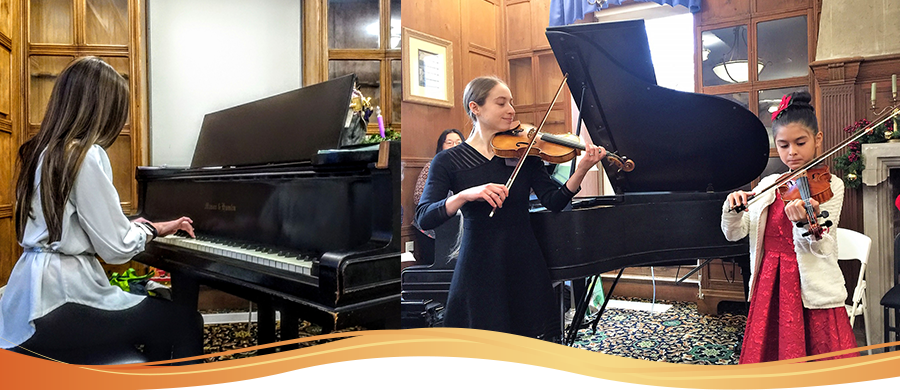
Online
Music for the Community
If you're interested in a particular category, you can sort performances by student age, instrument, singalong music, composer and so on - click on the orange tags under the text. We hope you and your family will enjoy watching our students share their music!
To have each week's videos and accompanying info sent to your inbox*, please subscribe via the orange button.
*Videos are delivered twice weekly; you can unsubscribe at any time, and we will never share or sell your info.
Subscribe to this Page
Displaying items by tag: Piano
Day 57 - Chant Arabe by Chwatal
Pianist age 8 plays "Chant Arabe" by F. X. Chwatal
Franz Xaver Chwatal (1808 – 1879) was a Bohemian pianist, composer and music teacher. He was the son of an organ builder, who gave him piano lessons as a child. He wrote many pieces of lighter popular music such as this one.
Like so many other pieces we’ve featured, this one is in A – B1/B2 – A form, giving it a pleasing symmetry. In the A section, you can hear the pianist’s left hand playing one chord that’s repeated over and over, like the unchanging, rhythmic plod of the camels across the desert.
There are several singalong options here – try them all, and let us know in the comments which one you like best!
(A) In far-off desert lands, where the oasis stands, camels in caravans trail across burning sands.
(B1) Riders in flowing turbans sit / high atop the swaying animals;
(B2) Bells tinkling, jingling, sweetly ring / out across the desert air and gently tell us...
(A) In far-off desert lands, where the oasis stands, camels in caravans trail across burning sands.
~ or ~
(A) I am thirsty and hot; I am thirsty and hot; I am thirsty and hot; I am thirsty and hot!
(B1) I sure would like some lemonade; / Mother may I? Honey, yes you may. (B2) I sure would like some lemonade; / will you get some for me now? Just wait a minute....
(A) I sure like lemonade; I sure like lemonade; I sure like lemonade, when I’m thirsty and hot.
~ or ~
(A) Oh, it’s hot, very hot! Oh, it’s hot, very hot! Oh, it’s hot, very hot! Oh, it’s hot, very hot!
(B1) Softly the camels tread with their / heavy load across the burning sand;
(B2) Under the blazing sun they plod / on and on and on across the endless desert....
(A) Oh, it’s hot, very hot! Oh, it’s hot, very hot! Oh, it’s hot, very hot! Oh, it’s hot, very hot!
Day 53 - Mary Had a Little Lamb (piano)
Pianist age 4 plays "Mary had a Little Lamb"
We've shown Mary had a Little Lamb before, on flute, but of course it sounds very different on piano. People are often surprised to learn that although the piano has strings, it's actually classifed as a percussion instrument. But percussion basically means "instruments that make their sound when you hit them," and that's what's happening here: when you press the piano keys, they operate hammers inside the piano, which hit the strings and bounce off again.
So an important skill for pianists is learning to touch the keys with enough strength for those hammers to produce a sound - but not so much that the sound is harsh. Although he's so young, you can see (and hear) that this young man is already doing an excellent job using the weight of his arm to drop his fingers into the keys, producing a round, ringing sound.
You probably already know that words to this song! But just in case:
Day 48 - Chopin Waltz in A Minor
Pianist age 11 plays Chopin Waltz in A minor
Day 47 - Lightly Row
Pianists age 6 and 8 play Lightly Row
Day 39: Not Jingle Bells; Row, Row, Row your Boat; and......?
Pianist age 6 plays "This is not Jingle Bells" and "Row, Row, Row your Boat"
Day 34: The Dance of the Spider and the Fly
Pianist age 8 plays "The Dance of the Spider and the Fly" by Donald Waxman
A native of Baltimore, Donald Waxman met his wife Jho at the Peabody Conservatory, and shortly after graduation the couple founded a music school in Nyack, New York. Like our Day 2 composer, Kabalevsky, the Waxmans felt that musical language in the piano methods of the time was dated, and not challenging or interesting enough for 20th century students.
Mr. Waxman says, “ I wanted young students to be working in a language more varied than that of so many piano method books. I wanted students to be playing and hearing music written in a wide variety of intervals, modes and tonal and chromatic combinations that go beyond the extreme limitations of music based primarily on the triads.” We think you’ll agree that he succeeded!
Day 26 - Early Beginners play Twinkle (Skills, part 1)
We're doing something a little different this week - taking you on a journey from the earliest stages of learning an instrument through to musical mastery. First, our beginners who are just learning to pick out a simple tune...
Pianists age 4 play Twinkle, right hand and left hand
Day 23: Beethoven’s “Für Elise"
Pianist age 11 plays Beethoven’s “Für Elise (For Elise)”
Who was the mysterious Elise for whom Beethoven wrote this short but very famous piece? There are quite a few possible candidates!
One is German soprano Elizabeth Rockel, who sang in Beethoven’s opera Fidelio. She met with Beethoven quite often, and it’s known that he wanted to marry her at one time. Another soprano called Elise Barensfeld has also been suggested, although less is known about her.
But in fact, what Beethoven actually wrote on the manuscript was not "Für Elise" - but "Für Therese"! It’s widely acknowledged that the Therese in question was Therese Malfatti, to whom Beethoven proposed marriage in 1810, the same year he composed the piece. As further evidence, she was also the owner of the manuscript.
She must have been rather put out when - thanks to a sloppy copywriter who made the 19th century equivalent of a typo - her name on the published version of the work was changed to someone else’s!
Day 18: "Just Struttin' Along" by Martha Mier
Pianist age 11 plays “Just Struttin’ Along” by Martha Mier
Martha Mier is an American composer and piano teacher who was born in 1936 and lives in Lake City, FL. She has written more than 60 books of catchy solo and duet pieces for piano students from elementary to advanced level.
Many of her pieces, including this one, are written in a jazz style (remember Tick Tock the Jazz Clock?). Her music is really fun to play!
Day 13: Cuckoo
Pianist age 6 plays "Cuckoo"
This easy piano piece from the Suzuki Piano Program is based on a German folk song, but we gave it English words to help students learn it.
Cuckoo, cuckoo sings from the forest.Cuckoo, cuckoo sings from the tree.
Let us be singing, let us be dancing,Cuckoo, cuckoo, springtime is here!
OR:
Cuckoo, Cuckoo, high in the treetops,Cuckoo, Cuckoo, sing me a song.
Sing in the morning, sing in the evening.Cuckoo, Cuckoo, I’ll sing along!


